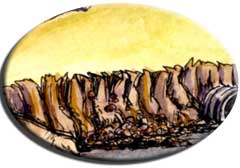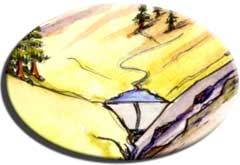Why are channel characteristics important?
 Channel characteristics describe what a channel looks like, including width, depth, gradient, substrate,
and bank stability. They also describe
the processes associated with a channel, particularly the movement of water and sediment. Healthy streams need to create a balance between sediment
entering and leaving the stream system. A disruption to sediment movement can result in erosion leading to bank instability or alternately to sediment
deposition leading to flooding problems.
Channel characteristics describe what a channel looks like, including width, depth, gradient, substrate,
and bank stability. They also describe
the processes associated with a channel, particularly the movement of water and sediment. Healthy streams need to create a balance between sediment
entering and leaving the stream system. A disruption to sediment movement can result in erosion leading to bank instability or alternately to sediment
deposition leading to flooding problems.
All streams carry sediment that has eroded from channels and the surrounding landscape. Streams then deposit this sediment further downstream in wetlands, floodplains, or channels. Natural streams carve a shape that allows them to carry their sediment and water loads, and tend to maintain a consistent depth and width over time, even as the stream course may change.
The construction of ditches, canals, and levees alters sediment and flow patterns alter the form of channels and can create sediment management
problems. Dams or other obstructions prevent sediment from moving downstream, while also blocking the migration of fish and other aquatic organisms.  Changes in drainage from the landscape adjacent to streams can alter the speed with which water enters a stream. Impervious surfaces, such
as concrete and asphalt, decrease the time it takes for flow to peak in a nearby channel after it rains, driving up the velocity and energy of
water in the stream channel. Streams that either carry a low amount of sediment or have high energy due to altered flow are known as “hungry
streams” and may erode sediment more rapidly from their channels and banks, threatening bank stability.
Changes in drainage from the landscape adjacent to streams can alter the speed with which water enters a stream. Impervious surfaces, such
as concrete and asphalt, decrease the time it takes for flow to peak in a nearby channel after it rains, driving up the velocity and energy of
water in the stream channel. Streams that either carry a low amount of sediment or have high energy due to altered flow are known as “hungry
streams” and may erode sediment more rapidly from their channels and banks, threatening bank stability.
Particularly aggressive erosion of channel beds is known as incision. In heavily incised streams with deep channels, natural flooding processes may be disrupted because the abnormal depth of the channel precludes water from spilling over the banks. An opposite condition occurs in streams that are overburdened with sediment. These streams may become too murky to support some species and may begin to deposit large amounts of sediment, creating another type of management challenge.
How do we measure channel characteristics?
In addition to the indicators listed on other pages, channel characteristics can be assessed through channel stability and sediment balance. Scientists also measure the width to depth ratio or cross section configuration of streams as an indicator of how connected a stream is to its adjacent floodplain.

